Work for yourself | Click here to proceed
Start working today | Join now
Submit your information
If you’re a healthcare professional, email marketing can be a great way to reach out to your patients and promote your services. Here are some tips for creating successful healthcare email marketing campaigns: 1. Keep your messages relevant and targeted.
Make sure the content of your emails is relevant to your recipients and their needs. 2. Keep it personal. Address your recipients by name and include personal details that will make them feel valued.
3. Make it interesting. Include engaging content that will capture your recipients’ attention and encourage them to read more. 4. Use images wisely.
Images can be a great addition to your emails, but make sure they’re used wisely so as not to overwhelm or distract from your message. 5. Call to action matters. Include a clear call to action in every email so that recipients know what you want them to do next.
Click Here to Start Work from Home Jobs
Email marketing is a great way to reach out to your healthcare audience. It allows you to stay in touch with current and potential patients, promote new services and events, and keep your brand top of mind. When planning your email marketing strategy, consider what you want to achieve and who your target audience is.
Keep your messages relevant and interesting, and make sure they are clear and concise. Include a strong call to action so that recipients know what you want them to do next. Test your emails before sending them out, and track the results so that you can see what works best.
And most importantly, always get permission from recipients before adding them to your email list. By following these tips, you’ll be able to create successful healthcare email marketing campaigns that will help you achieve your goals.
Healthcare Marketing Strategies: Email Marketing Tips For Healthcare
What are the 5 P’S of Healthcare Marketing?
The 5 P’s of healthcare marketing are: 1. Product – What is the healthcare product or service that you are offering? 2. Price – What is the price of your healthcare product or service?
3. Place – Where will your healthcare product or service be available? 4. Promotion – How will you promote your healthcare product or service? 5. People – Who is your target market for your healthcare product or service?
What are the 4 Types of Marketing Emails?
The four types of marketing emails are promotional, transactional, triggered, and welcome emails. Promotional emails are sent to customers and prospects with the intention of selling a product or service. They typically include discounts, special offers, or new product announcements.
Transactional emails are sent in response to an action taken by the recipient, such as confirmations, shipping notifications, password reset instructions, etc. Triggered emails are sent based on customer behavior or interactions with your business. Welcome emails are sent to new subscribers or customers as a way to introduce them to your brand and build rapport.
Each type of email serves a different purpose and can be used in different ways to support your marketing goals. When designing your email marketing campaigns, it’s important to consider what type of email will best suit your needs.
What are the 4 P’S of Healthcare Marketing?
In healthcare marketing, the 4 P’s are Product, Price, Place, and Promotion. Product: The first “P” in healthcare marketing is product.
This refers to the medical services or products that your facility offers. When deciding on your product mix, it’s important to consider what needs your patients have and how your products or services can meet those needs. You should also think about what makes your products or services unique and how you can differentiate them from those of your competitors.
Price: The second “P” is price. Pricing is a critical element of any healthcare marketing plan as it can impact both demand and revenue.
In general, patients are more price-sensitive when it comes to elective procedures than they are for necessary treatments. That said, it’s still important to consider both cost and value when setting prices for your products and services. Cost-conscious consumers will want to know that they’re getting a good deal, while those who place a higher importance on quality may be willing to pay more for superior care.
Place: The third “P” is place. This refers to the location of your facility as well as the channels through which you distribute your product or service.
For example, if you offer home health services, then patients’ homes would be considered your place of business. Similarly, if you sell medical supplies online, then the internet would be one of your distribution channels. When choosing a location for your facility, you’ll want to consider factors such as accessibility, parking availability, and public transportation options.
As for distribution channels, it’s important to select ones that will reach your target market most effectively. Promotion: Finally, we come to promotion – the fourth “P” in healthcare marketing . This encompasses all of the communications strategies that you use to raise awareness about your brand and persuade people to use your products or services . Some common promotional tactics used in healthcare marketing include advertising , direct mail , public relations , and community outreach .
How is Email Used in a Healthcare Setting?
Email is an important part of healthcare communication. It can be used to communicate with patients, providers, and other members of the healthcare team. Email can be used to send appointment reminders, test results, and health information.
It can also be used to ask questions and get advice from providers.
Click Here to Start Work from Home Jobs

Credit: www.10xdigitalinc.com
Healthcare Email Templates
Email templates are a great way to stay organized and efficient when communicating with healthcare providers. By having a few key templates on hand, you can quickly and easily send important information without having to start from scratch each time. When it comes to healthcare email templates, there are a few key types that are essential for any medical practice or hospital.
Below is a list of the most common healthcare email templates: 1) Appointment Confirmation Template: This template can be used to confirm appointments with patients or other healthcare providers. It should include all pertinent details such as date, time, location, and provider name.
2) Appointment Reminder Template: This template can be used to remind patients of upcoming appointments. It should include the date, time, and location of the appointment, as well as any special instructions (e.g., “Please bring your insurance card”). 3) test results Template: This template can be used to deliver test results to patients or other healthcare providers.
It should include pertinent details such as the type of test, the results, and any next steps that need to be taken. 4) Referral Template: This template can be used when referring patients to specialists or other hospitals/medical practices. It should include the patient’s name, contact information, and reason for referral.
5) Billing Statement Template: This template can be used to send billing statements to patients or other responsible parties (e.g., insurance companies).
Healthcare Email Marketing Best Practices
Email marketing is a powerful tool for healthcare organizations. It allows you to reach a large audience with your message and can be a cost-effective way to promote your brand and services. But before you start sending out emails, there are some best practices you should follow to ensure your campaigns are successful.
1. Know Your Audience Before you can start crafting effective email content, you need to know who your target audience is. What are their needs and wants?
What kind of information would they be interested in receiving? Once you have a good understanding of your audience, you can start creating content that appeals to them. 2. Keep It Relevant
Your email content should always be relevant to your audience. No one wants to receive irrelevant and uninteresting emails – they’ll just hit the delete button without even reading them. Make sure every email you send has something valuable for your recipients, whether it’s educational information, special offers, or news about upcoming events.
3. Use an Engaging Subject Line Your subject line is the first thing recipients will see when they receive your email, so it’s important to make it catchy and interesting enough that they’ll want to open it. Avoid using generic phrases like “newsletter” or “update” in your subject line; instead, try something more specific that will pique recipient curiosity such as “5 Ways You Can Improve Your Health This Winter” or “3 Tips For Staying Healthy During Cold & Flu Season” .
Health Insurance Email Marketing
Email marketing can be a great way to reach out to potential customers about your health insurance products and services. Here are a few tips to get started: 1. Keep your messages relevant and targeted.
Make sure the information you include in your emails is relevant to your target audience and that it resonates with them. 2. Personalize your messages. Include the recipient’s name in the email subject line and body to make it more personal.
3. Use a strong call-to-action. Your email should encourage recipients to take action, such as visiting your website or contacting you for more information. 4. Test, test, test!
Always test your email campaigns before sending them out to ensure they’re working correctly. This includes testing things like subject lines, images, and call-to-actions. 5. Monitor results and adjust accordingly .
Click Here to Start Work from Home Jobs
Conclusion
Healthcare email marketing is a great way to reach out to potential and current patients. It can help promote your brand, increase patient loyalty, and boost appointment bookings. However, before you start sending out emails, there are a few things you need to keep in mind.
First, make sure your email list is up-to-date and accurate. Secondly, segment your list so that you can send targeted messages to specific groups of people. Lastly, craft compelling content that will encourage recipients to take action.
By following these tips, you can maximize the success of your healthcare email marketing campaign!




